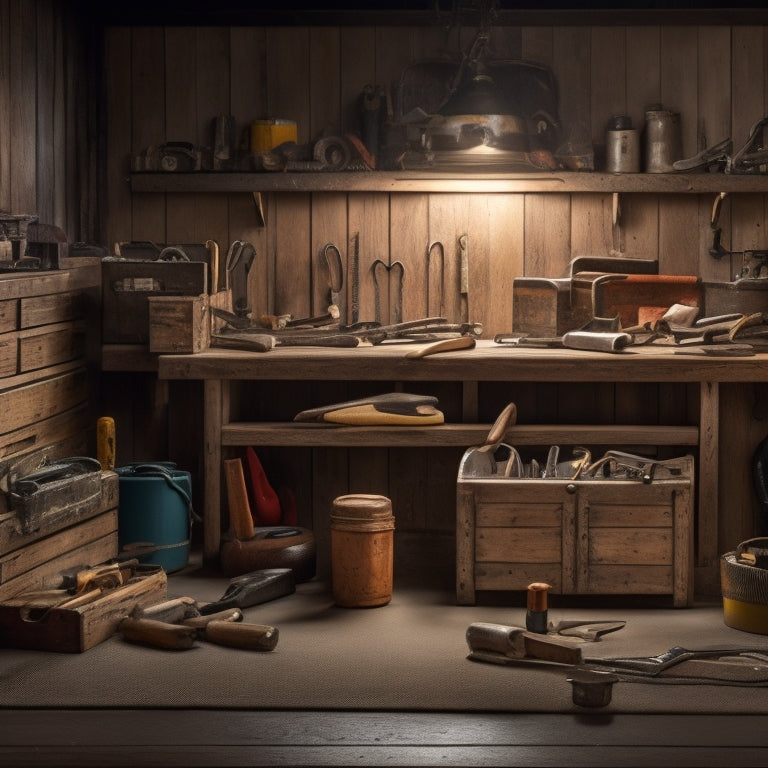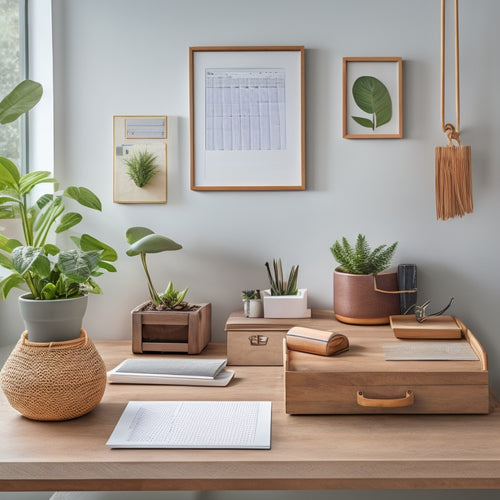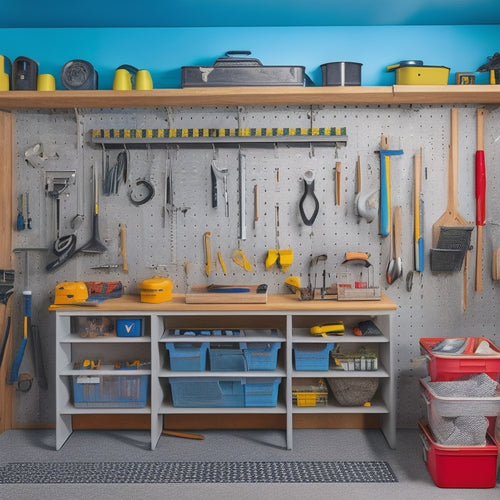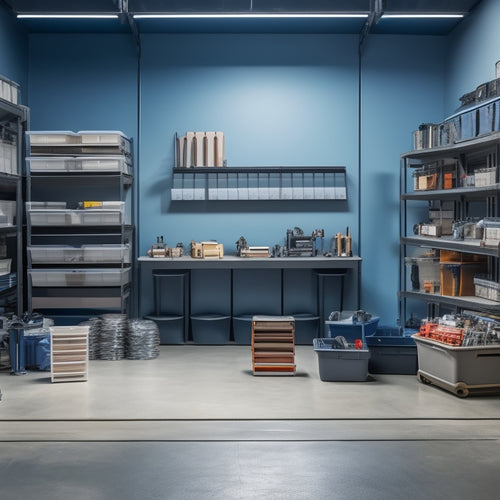
What Tools Should Be in a Homeowner's Tool Box Set
Share
You'll want a well-rounded tool box set that covers the basics and beyond. Start with essential hand tools like a hammer, level, and pliers, as well as fundamental power tools like a cordless drill and circular saw. Don't forget fastening and joining tools, cutting and shaping tools, and measuring and testing tools. Specialized tools for plumbing, electrical, and safety tasks are also vital. From there, you can add more specialized tools to tackle specific projects. With a solid foundation and the right tools, you'll be equipped to tackle a wide range of DIY projects and maintenance tasks - and you're just getting started on building your skills.
Key Takeaways
- A homeowner's tool box set should include essential hand tools like hammers, pliers, screwdrivers, wrenches, and tape measures for basic tasks.
- Basic power tools like cordless drills, impact drivers, and circular saws are crucial for various projects and tasks around the house.
- Cutting and shaping tools such as handsaws, circular saws, jigsaws, and sandpaper are necessary for woodworking and other DIY projects.
- Measuring and testing tools like tape measures, voltage testers, and circuit testers ensure accuracy and safety in electrical and plumbing work.
- Safety and protective gear like safety glasses, gloves, and a first aid kit are essential for preventing injuries and ensuring emergency preparedness.
Essential Hand Tools for Homeowners
Your trusty hammer is likely the first tool that comes to mind when thinking about essential hand tools for homeowners. But, it's not the only one. A well-stocked tool box should include a level, pliers, screwdrivers, wrenches, and a tape measure.
These tools will help you tackle everyday tasks, from hanging an image to fixing a leaky faucet.
To guarantee your tools remain in top condition, follow some simple tool maintenance tips. Regularly clean your tools to prevent rust and corrosion. Store them in a dry place, away from direct sunlight.
Lubricate moving parts to keep them running smoothly.
Implementing tool organization strategies will also save you time and frustration. Assign a designated spot for each tool, making it easy to find what you need when you need it.
Consider investing in a tool chest or pegboard to keep your tools organized and within reach. By following these tips, you'll be well-equipped to handle any task that comes your way.
Basic Power Tools for DIY Projects
You'll find that having the right power tools can greatly simplify your DIY projects and make them more efficient.
A cordless drill is an essential power tool that you'll use frequently, so it's important to choose one that fits your needs.
Additionally, a rotary tool can be a versatile addition to your toolbox, with uses that range from grinding and cutting to sanding and polishing.
Cordless Drill Essentials
Three essential power tools form the foundation of any DIY project: a cordless drill, impact driver, and circular saw. Of these, your cordless drill is likely to be the most used tool in your arsenal.
When selecting a cordless drill, look for key features such as variable speed, adjustable torque, and a high-capacity battery. These features will give you the versatility to tackle a wide range of projects, from hanging a photo frame to drilling through thick wood.
To guarantee your cordless drill remains a reliable workhorse, regular maintenance is vital. Check your drill's battery regularly, storing it in a cool, dry place when not in use.
Clean the drill's chuck and exterior regularly to prevent dust and debris buildup. Additionally, lubricate the drill's gears and bearings according to the manufacturer's instructions. By doing so, you'll extend the life of your drill and prevent costly repairs.
Rotary Tool Uses
When tackling DIY projects, having the right tools can make all the difference. A rotary tool is one of the most versatile power tools you can own, and its uses go far beyond just drilling holes. With the right attachments, a rotary tool can become a grinder, sander, cutter, and more.
One of the key benefits of a rotary tool is its versatility. With a variety of attachments available, you can use it for a wide range of tasks, such as:
- Cutting through metal pipes or conduit with a diamond-coated blade
- Sanding down rough wood surfaces with a sanding drum
- Grinding away rust or corrosion with a metal grinding stone
- Carving intricate designs into wood or metal with a rotary carving bit
The rotary tool's compact size and lightweight design make it easy to maneuver into tight spaces. Its variable speed control allows you to adjust the speed to suit the task at hand.
With a rotary tool in your tool box, you'll be amazed at how often you reach for it to tackle a variety of DIY projects.
Fastening and Joining Tools
Fastening and joining tools are the backbone of any DIY project, enabling you to drive, screw, nail, and bond materials together to create something new. These tools guarantee your projects are secure, stable, and long-lasting.
You'll need a variety of screwdrivers to tackle different screw types, such as flathead, Phillips, and hex (or Allen) drivers. Invest in a screwdriver set that includes both manual and powered options.
When it comes to joining techniques, you'll want to master basic skills like hammering, tapping, and clamping. A hammer is essential for driving nails, fitting parts together, and breaking apart objects.
You'll also need a tape measure, level, and clamps to guarantee accurate measurements and secure holds. Don't forget a set of nails, screws, and wall anchors to accommodate various materials and applications.
Cutting and Shaping Tools
You've secured your materials with the right fastening and joining tools, now it's time to shape and size them to fit your project's needs. Cutting and shaping tools are essential for any homeowner, and having the right ones can make all the difference in the quality of your work.
To get started, you'll need a variety of saws, including:
- A handsaw or backsaw for precise cuts
- A circular saw for making straight cuts in larger materials
- A jigsaw or reciprocating saw for curved cuts and demo work
- A miter saw or coping saw for precise angled cuts
When it comes to shaping techniques, you'll want to take into account the type of material you're working with. For example, sandpaper and files are great for smoothing out wood, while a grinder or rotary tool can be used to shape metal or stone.
Remember to always follow safety guidelines when working with power tools, and take the time to practice your techniques to avoid accidents and errors.
Measuring and Testing Tools
You'll use measuring and testing tools frequently to guarantee your projects are accurate and safe.
A good tape measure is essential for taking precise readings, and you'll want to know its basics, such as how to correctly read the markings and use the lock mechanism.
Additionally, a voltage tester is a must-have for detecting electrical currents, and understanding its essentials will help you avoid hazardous situations.
Tape Measures Basics
Get familiar with your tape measure, a workhorse in your toolbox that helps you size up any project. You'll use it to measure rooms, furniture, and materials, making it a vital tool for any DIY enthusiast or homeowner.
There are several tape measure types, including standard, fractional, and digital measures. Each has its own strengths, so it's important to choose the right one for your project.
When it comes to tape measuring techniques, here are a few tips to keep in mind:
- Always hold the tape measure level and straight to guarantee accurate readings.
- Use the correct unit of measurement for your project, whether it's inches, feet, or meters.
- Take multiple readings to verify accuracy, especially when measuring large areas.
- Use the locking mechanism to hold the tape in place, allowing you to take precise measurements without worrying about the tape slipping.
Voltage Tester Essentials
Most voltage testers fall into one of two categories: non-contact and contact testers. When choosing a voltage tester, it's crucial to understand the differences between these types and how to use them safely.
| Voltage Tester Types | Description |
|---|---|
| Non-Contact Testers | Detect voltage without touching wires or conductors |
| Contact Testers | Require direct contact with wires or conductors |
| Multi-Function Testers | Combine voltage testing with other functions (e.g., current, resistance) |
| LED Testers | Use light-emitting diodes to indicate voltage presence |
| Digital Testers | Display voltage readings numerically |
You'll use your voltage tester to verify the absence of voltage before starting electrical work, guaranteeing your safety. Always follow the manufacturer's instructions and take necessary precautions when using a voltage tester. Remember to test the tester itself regularly to confirm it's functioning correctly. By selecting the right voltage tester for your needs and using it properly, you'll reduce the risk of electrical shock and work more efficiently.
Plumbing and Water Tools
A well-stocked toolbox isn't complete without a set of plumbing and water tools to help you tackle common issues and maintenance tasks around the house.
You never know when you'll need to fix a leaky faucet or unclog a stubborn drain. Having the right tools on hand can save you time, money, and frustration.
Here are some essential plumbing and water tools you should consider including in your toolbox:
- Pipe wrenches: for gripping and twisting pipes to loosen stuck fittings or remove old pipes
- Leak detectors: to help you identify hidden water leaks behind walls or under floors
- Plumbing snakes: for clearing clogs in sink drains, toilets, and showers
- Drain uncloggers: for dissolving grease and other blockages that can cause slow draining or backups
With these tools, you'll be better equipped to handle routine plumbing tasks, such as faucet repairs and checking water pressure.
Remember to always follow safety guidelines and take necessary precautions when working with water and pipes to avoid injury or further damage.
Electrical and Lighting Tools
Now that you've got the basics of plumbing and water tools covered, it's time to shift your attention to the electrical and lighting systems in your home. As a homeowner, it's crucial to have the right tools to tackle minor electrical tasks and troubleshooting.
You'll need a wire stripper to remove insulation from electrical wires. This tool is handy for repairing lamps, outlets, or switches. A circuit tester is another must-have for verifying the safety of your electrical system. It helps you identify which circuit a particular outlet or fixture is connected to, making it easier to troubleshoot issues.
Additionally, consider adding a voltage tester, which detects the presence of voltage in a circuit, and a non-contact voltage detector, which senses voltage without making physical contact with the wire.
These tools will assist you in diagnosing electrical problems and guarantee your safety while working on electrical projects. Remember to always follow safety guidelines and turn off the power to the circuit before starting any electrical work.
Safety and Protective Gear
You'll frequently find yourself in situations where safety and protective gear are essential when working on electrical and plumbing projects around the house.
Whether you're dealing with sharp objects, electrical currents, or hazardous materials, having the right gear can mean the difference between a successful project and a trip to the emergency room.
To guarantee you're well-prepared, make sure you have the following safety and protective gear in your tool box:
- Protective eyewear, such as safety glasses or goggles, to shield your eyes from debris and chemicals
- Safety gloves, like rubber or latex gloves, to protect your hands from cuts, abrasions, and electrical shock
- A first aid kit, stocked with essentials like bandages, antiseptic wipes, and pain relievers
- A dust mask or respirator, to prevent inhalation of harmful particles and fumes
Miscellaneous but Important Tools
In addition to the essential tools and safety gear, having a few miscellaneous tools on hand can make all the difference in the efficiency and success of your projects.
You'll be surprised how often you'll reach for these tools to get the job done. A level, for instance, guarantees that your shelves and cabinets are properly aligned, while a stud finder helps you locate studs behind walls for secure fastening. A cordless multi-tool can come in handy for various tasks, such as cutting, grinding, and sanding.
For tool maintenance, you'll need a few essentials like a tool sharpener and a lubricant to keep your tools in top condition. A toolbox organizer can also help you stay organized and find what you need quickly.
In home repair, a drain snake can help you clear clogs, and a fire extinguisher is a must-have in case of emergencies.
Don't underestimate the importance of these miscellaneous tools – they can save you time, effort, and even money in the long run.
Frequently Asked Questions
How Often Should I Clean and Maintain My Tool Box Set?
You should clean and maintain your tool box set regularly, ideally every 1-2 months, to guarantee tool organization and prevent rust, checking for damage and worn-out parts, and lubricating moving components for peak performance and safety.
Can I Use Tool Boxes Made of Plastic or Fabric?
Did you know 75% of homeowners use their toolboxes daily? You can use plastic tool boxes, which offer durability, or fabric storage options, which provide flexibility, but prioritize safety by choosing a sturdy, rust-resistant material that protects your tools.
Are Tool Boxes With Wheels or Handles Better?
When choosing between tool boxes with wheels or handles, you'll want portable options that fit your needs. Consider handles for smaller, lighter loads, and wheels for heavier ones, ensuring you prioritize organizational features for safe, efficient storage.
Can I Customize My Tool Box Set to Fit My Needs?
It's no coincidence you're thinking of customizing your tool box set - it's a smart move! You can opt for custom tool options and personalized storage to fit your specific needs, ensuring you're well-equipped and safe on the job.
How Do I Prevent Tool Box Theft or Loss?
You'll want to prioritize tool security to prevent theft or loss; consider anchoring your tool box to a wall, using a lock, and keeping it out of sight, while also labeling your tools with identifying marks to deter theft.
Conclusion
You've got the ultimate homeowner's tool box set! With these must-haves, you'll be a DIY expert, tackling tasks with ease and confidence. From tightening loose screws to fixing leaky faucets, you'll be the hero of your own home. And with this arsenal, you'll be prepared to tackle a million projects (okay, maybe not a million, but you get the idea!) - saving time, money, and your sanity.
Related Posts
-

Best Organizing Tools for a Clutter-Free Space
You're on a mission to change your cluttered space into a peaceful oasis, and you're looking for the best organizing ...
-

Advantages of a Pegboard System in Your Garage
You can instantly alter your garage into a more organized, efficient, and productive space by installing a pegboard s...
-

How to Maximize Storage Space With Parts Storage Bins
To maximize storage space with parts storage bins, start by evaluating your available storage space and examining you...


